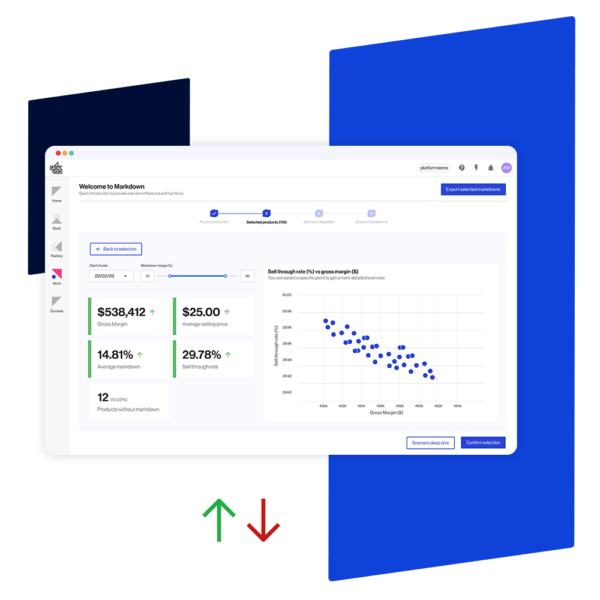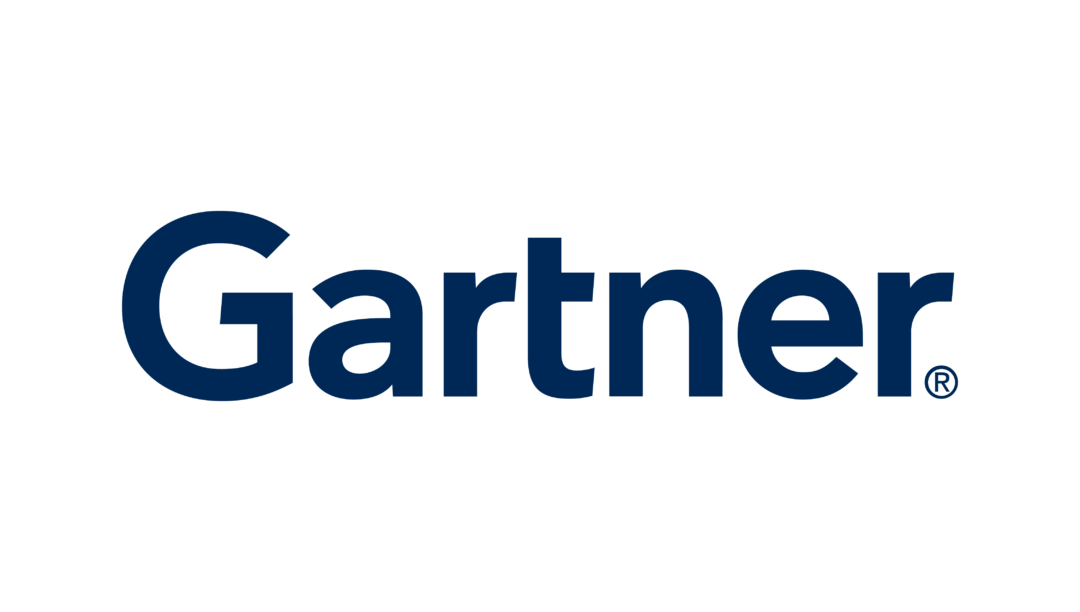
Markdown
Optimize markdown with AI
SKU-level markdown optimization software that provides suggestions for merchandising teams who want to say goodbye to the hours spent in spreadsheets

Stop leaving profit on the table and start leveraging markdown optimization in retail
Retailers around the world invest more than $1 trillion in their markdown programs (BCG). Stop leaving profit on the table and out-of-season inventory in the stockroom.
It’s time to add AI and optimize your markdown.
Taking your business targets into account
Peak’s markdown optimization software gives you SKU-level markdown suggestions for any location or channel. It does this by applying AI models to your inventory, transaction and pricing data, while taking into account business targets and constraints.
Maximize your most important metrics
Visualize different scenarios of markdowns and the metrics achieved for each. Explore the breakdown of % discounts given, markdowns in different markets, and product level suggestions.
-
Increase sell through
-
Increase gross profit
-
Clear stock within season
-
Reduce manual decision making and save time
Under the hood
Markdown applies AI models to your inventory, transaction and pricing data, taking into account business-specific targets and constraints, to provide you with SKU-level markdown suggestions for any location or channel.
- Application users
- Features & benefits
- Actions & results
See Peak's Markdown optimization tool in action
Peak named in Gartner's Market Guide for Retail Unified Price, Promotion and Markdown Optimization Applications — ShortLife Cycle
Our Markdown optimization application has been included in a 2022 Gartner Market Guide.

Markdown optimization – retailers, there is another way!
FAQs
What is markdown optimization?
Markdown optimization is a strategic approach employed by retailers to maximize the effectiveness of markdown pricing strategies and drive sales while minimizing the impact on profit margins. A markdown is a reduction in the original selling price of a product, typically used to clear excess inventory, stimulate demand or respond to market dynamics.
Key aspects of markdown optimization include:
- Data analysis: Retailers analyze historical sales data, customer behavior and market trends to identify opportune moments for implementing markdowns. This data-driven approach helps in making informed decisions about when and how much to discount products.
- Timing and seasonality: Understanding the timing of markdowns is crucial. Markdown optimization takes into account factors such as seasonality, product lifecycle and market demand fluctuations to strategically time price reductions for maximum impact.
- Segmentation and targeting: Effective markdown optimization involves segmenting the customer base to tailor discounts to specific demographics, buying behaviors or geographic locations. This targeted approach enhances the relevance of markdowns and increases customer engagement.
- Dynamic pricing: Retailers employ dynamic pricing strategies as part of markdown optimization, adjusting prices in real-time based on factors such as inventory levels, competitor pricing and customer demand. This flexibility ensures a competitive edge in the market.
- Clearance and inventory management: Markdown optimization is closely tied to inventory management. It helps retailers clear excess or slow-moving inventory efficiently, preventing overstock situations and freeing up resources for newer products.
- Promotion integration: Coordinating markdowns with other promotional activities enhances the overall impact. Markdown optimization considers how price reductions align with broader marketing strategies, ensuring a cohesive and effective approach to sales promotion.
- Profitability analysis: Retailers conduct thorough analyses to assess the impact of markdowns on profitability. This includes evaluating the cost of goods sold (COGS), gross margins and overall financial performance to determine the success of markdown optimization strategies.
- Customer experience: Balancing the need for markdowns with maintaining a positive customer experience is crucial. Markdown optimization aims to offer value to customers without compromising brand perception, loyalty or perceived product quality.
Implementing effective markdown optimization requires a combination of advanced analytics, technology and strategic planning. Retailers leverage tools and systems that facilitate dynamic pricing, monitor market conditions and provide insights for informed decision making.
In conclusion, markdown optimization is a vital component of retail strategy, enabling businesses to navigate market challenges, manage inventory efficiently and drive sales while maintaining healthy profit margins. By embracing a data-driven and customer-centric approach, retailers can optimize markdowns to achieve both short-term goals and long-term sustainability.
What are the benefits of markdown optimization?
Markdown optimization offers several key benefits for retailers seeking to maximize sales, manage inventory efficiently, and enhance overall profitability. These advantages include efficient inventory management, maximized sales performance and improve profit margins. Let’s look at some of these advantages, and more, in more detail:
- Efficient inventory management: One of the primary benefits of markdown optimization is the ability to manage inventory more efficiently. By strategically applying markdowns to products, retailers can clear excess or slow-moving inventory, preventing overstock situations and minimizing carrying costs.
- Maximized sales performance: Markdown optimization aims to enhance sales by strategically timing and pricing discounts. By analyzing market trends, customer behavior and seasonality, retailers can offer discounts that appeal to consumers, stimulating demand and increasing sales.
- Improved profit margins: While markdowns are designed to boost sales, effective optimization ensures that profitability is maintained. Retailers can strategically adjust prices to find the optimal balance between driving sales and preserving profit margins, contributing to overall financial health.
- Enhanced customer engagement: Targeted markdowns, based on customer segmentation and preferences, contribute to a more engaging customer experience. By tailoring discounts to specific demographics or buying behaviors, retailers can increase customer loyalty and satisfaction.
- Clearance of excess inventory: Markdown optimization is a valuable tool for clearing out excess or end-of-season inventory. This proactive approach prevents the accumulation of obsolete stock, freeing up space and resources for new products.
- Dynamic pricing adaptability: Retailers can leverage dynamic pricing strategies as part of markdown optimization, adjusting prices in real-time based on factors such as competitor pricing, inventory levels and market demand. This adaptability provides a competitive edge in the market.
- Strategic timing of discounts: Timing is critical in retail, and markdown optimization allows retailers to strategically time discounts for maximum impact. Whether responding to seasonal shifts, holidays or market trends, retailers can align markdowns with opportune moments.
- Data-driven decision making: Markdown optimization relies on data analytics to inform decision making. Retailers can analyze historical sales data, customer feedback and market trends to make informed choices about when, where and how much to markdown.
- Balanced customer perception: Carefully planned markdowns contribute to a balanced customer perception of the brand. By offering discounts strategically, retailers can maintain the perceived value and quality of their products while providing attractive pricing to customers.
- Competitive advantage: Retailers implementing effective markdown optimization can gain a competitive advantage. The ability to offer appealing discounts while maintaining profitability sets businesses apart in the market, attracting and retaining customers.
In summary, markdown optimization is a multifaceted strategy that brings numerous benefits to retailers. By leveraging data, technology and strategic planning, businesses can optimize their markdowns to achieve a harmonious balance between increased sales, efficient inventory management, and sustained profitability.
What is an example of markdown optimization?
A practical example of markdown optimization can be seen in the retail industry during seasonal clearance sales. Imagine a fashion retailer with a surplus of winter apparel as the season transitions to spring. To efficiently manage inventory and maximize sales, the retailer employs markdown optimization strategies.
- Data analysis: The retailer analyzes historical sales data, considering factors such as which winter items sold well, customer preferences and the average duration of previous clearance sales.
- Segmentation: Understanding their diverse customer base, the retailer segments shoppers based on demographics, buying behavior and geographic location. This segmentation helps tailor discounts to specific customer preferences.
- Dynamic pricing: Leveraging dynamic pricing tools, the retailer adjusts prices in real-time based on inventory levels, competitor pricing and market demand. This ensures that discounts are competitive while maintaining profitability.
- Timing: Recognizing the seasonal shift, the retailer strategically times the clearance sale to coincide with the peak demand for spring apparel. This not only clears winter inventory efficiently but also attracts customers looking for discounted items during the transition.
- Multi-channel integration: The retailer integrates the clearance sale across various channels, including the physical stores and online platforms. This ensures a seamless and consistent shopping experience for customers, regardless of their preferred shopping channel.
- Promotion integration: In addition to price reductions, the retailer integrates the clearance sale with other promotional activities. This could include email marketing campaigns, social media promotions and in-store displays to create awareness and drive traffic.
- Customer engagement: By offering targeted discounts on winter items that align with customer preferences, the retailer engages its customer base effectively. This not only attracts existing customers but also has the potential to reach new ones through word of mouth and positive reviews.
- Feedback and adjustment: Throughout the clearance sale, the retailer monitors customer feedback, sales performance and inventory levels. This data-driven approach allows for real-time adjustments, such as increasing discounts on slower-moving items or replenishing popular products.
- Profitability analysis: Post-sale, the retailer conducts a thorough analysis of the clearance event, assessing the impact on profitability. This analysis includes evaluating the cost of goods sold (COGS), gross margins and overall financial performance during and after the promotion.
By applying these markdown optimization strategies, the retailer efficiently clears winter inventory, maximizes sales, engages customers and maintains profitability. This example illustrates how markdown optimization is a dynamic and data-driven process that enables retailers to navigate seasonal changes and market demands effectively.






